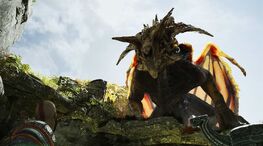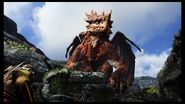
Fafnir was a dwarf but got turned into a dragon because of greed.
Dragons are massive reptilian predators seen in God of War (2018) and God of War: Ragnarok. Several variants appear across the two games, including: larger, six-limbed Dragons native to Midgard, smaller, four-limbed Dragons native to Svartalfheim, crocodilian Dreki native to Vanaheim, and huge, wingless Drakes, native to Alfheim. The three non-Midgardian species can be found scattered across a number of realms by the time of the two games due to manipulations and sabotaging from Odin.
Quick Answers
What are the different types of dragons in God of War 2018 and Ragnarok?

How do the dragons in God of War: Ragnarok differ from those in Midgard?

What are some strategies for killing dragons in God of War?

What is the significance of dragons in the 'Across the Realms' favor in God of War?

Mythology[]
Dragons are large serpent-like legendary creatures that appear in the folklore of many cultures around the world. Beliefs about dragons vary drastically by region, but dragons in western cultures since the High Middle Ages have often been depicted as winged, horned, four-legged, and capable of breathing fire. Dragons in eastern cultures are usually depicted as wingless, four-legged, serpentine creatures with above-average intelligence.
Famous prototypical dragons include the Python, Ouroborus, Typhon, and the Lernaean Hydra (in addition, Drakaina, Ladon, The Colchian Dragon, The Ismenian Dragon, Helios' Dragons, Ethiopian Dragon, Indian Dragon, Scythian Dracaenia, and Giantomachian Dragon) in Greek mythology, Leviathan in the Hebrew Bible, and Jörmungandr, Níðhöggr, Fafnir, Lindworm, and Sea Serpents in Norse mythology. Basilisk are sometimes categorized as dragons, too.
In the God of War series[]
Dragons in this game are very similar to the Western depiction of dragons, being giant feral reptiles with horns and wings. Some dragon species appeared smaller with only two legs while Drakes appeared as giant and wingless behemoths. All but one of the dragons is confirmed to breathe fire, although their fire breath is more of an explosive combination of flame and lightning. They have an ability to perceive Dwarves even when they "walk between realms". Most dragons show the capability of flight, and they are generally extremely aggressive.
History[]
Centuries ago there was an event known as the "Grand Culling of the Wyrms", which resulted in the demise of many Dragons. The reason why it was carried out and by whom is still unknown, but it was presumably in Midgard, as its native Dragon species is the only shown to have dwindling numbers.
God of War (2018)[]
Kratos and Atreus encounter some of them during their journey. The first they cross paths with is Hræzlyr, a male Dragon that attacked them while they were making their way up to the summit of the highest Mountain in Midgard. Kratos engages in battle against the Dragon when the father and son find him threatening Sindri.
A male Dragon, Dagsetr, is used by Baldur for transportation. It was on him that Baldur attempted to take Atreus to Asgard, starting a battle with Kratos heavily wounding Dagsetr, causing the Dragon to plummet towards the ground resulting in his demise. Dagsetr's corpse can be found near Jörmungandr, a place where a Dragon Tear can be collected.
Dragon Favours[]
In different regions across Midgard, there are three dragons that are chained up, and the goal is to free them from their bindings. In order to do so, all three dragon shrines located near the dragon must be destroyed. Practice caution, however, as their attacks cause damage on both Kratos and his enemies with charged beams and lightning strikes. Otr is the most dangerous of the other two at least while being chained.
Freeing all three dragons will yield the Dangerous Skies trophy as well as many crafting items unique to dragons.
The Flight of Fafnir[]
- Location: Council of Valkyries
- Dragon Shrine #1: To the left of the anchor.
- Dragon Shrine #2: Jump to the cliff to the right of the anchor and then climb up to reach the shrine, which is guarded by a Traveler.
- Dragon Shrine #3: From the second shrine, stay up high and lift the gate from the cave, going around to the next chamber with a final shrine.
The Fire of Reginn[]
- Location: Konunsgard
- Dragon Shrine #1: Left of the anchor. Jump the fallen bridge and find it in the arena below.
- Dragon Shrine #2: Continue along the cliffs (to your right) to find a dark cave past the first shrine.
- Dragon Shrine #3: Behind the rune door opposite the first shrine. Ring the three bells in the area to open the door.
Otr's Imprisonment[]
- Location: Veithurgard
- Dragon Shrine #1: Up the hill, to the right of the anchor.
- Dragon Shrine #2: Turn left from the anchor, and stick to the left edge up the hill path.
- Dragon Shrine #3: Reach the far end of the broken bridge and match the runes on the door to unlock it.
God of War: Ragnarök[]
There are several Dragons of various colors and types appear, and new types of dragons called Dreki and Drakes.
One even joins during the battle of Ragnarök, where it acts as both an enemy and a hazard in which it will breathe fire on random parts of the battlefield which can cause damage to anyone. Additionally, several Dragons appear as bosses in side quests, where it is shown that they have invaded Vanaheim and Alfheim among others. Many of these dragons are named: the Crimson Dread, the Corpse Eater, the Ash Tyrant, Gravel Belly, Crag-Jaw, Slag Horn, and The Everlasting, the last of which can only be awakened in Svartalfheim using a relic called the Mythical Heirloom in front of it, causing the dragon to awaken from its stone sleep. A final dragon, known as the Pale One, serves as an underling to the Raven Keeper, a revenant that serves Odin that Kratos can hunt down in a side quest with Atreus or Freya after killing all of Odin's spectral ravens. The Corpse Eater steals Kratos' kill by taking away the Ogre and eating it,
Known Dragons[]
Trivia[]
- The facial structures of the dragons resemble those of ceratopsian dinosaurs, with characteristics including beaks, horns, and frills.
- The three imprisoned dragons are relatives in Norse mythology. Fafnir, Otr, and Reginn are the children of the sorcerer Hreiðmarr. Otr was able to turn into an otter and was accidentally killed by the god Loki, and Fafnir and Reginn were both killed by the hero Sigurd. Fafnir is the only one of the three who turns into a dragon after possessing the cursed ring of Andvari, Andvaranaut.
- This remains true in God of War. In fact Mimir attributed their intelligence to the variants seen in God of War: Ragnarök to their origin as Dwarves.
- Given the dragons are able to see dwarves while they're stepping between realms, it's possible that Dragons can pass between realms. This would explain how Baldur was able to travel to Midgard while Tyr's Temple was still underwater.
- Some of the original concept art for Hræzlyr seems to have been utilized in the design of Níðhögg, such as the ability to suck boulders into the stomach via dimensional rifts.
- In God of War: Ragnarök, the Dragons seen are originally native to Svartalfheim, which are smaller and have two fewer limbs than the larger Midgardian Dragons seen in God of War (2018).
- While Níðhögg, the other Lindwyrms, and Wyverns all display dragon-like characteristics, they are not considered to be dragons by the definitions of the nine realms.















